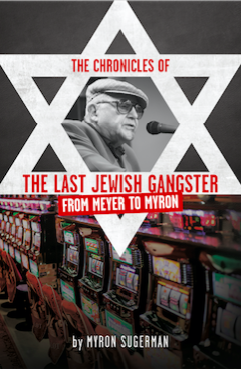If anyone at our company is going to seek out a book to read depicting someone’s gaming machine memoirs, it is going to be me.

I qualify on the grounds of longevity. So when we learned that Myron Sugarman had written a book (lots of people in the industry reckon they’re going to, but few actually do) and that it had been published, then we felt we had to see it.
Titled The Chronicles of the Last Jewish Gangster, it is the life story of one of the industry’s best-known "characters" who, thankfully, is still with us. Myron is in his late 70s, is mostly retired now and lives in New Jersey. His chronicles date back to 1959, a few years earlier than my own history in the industry, and consist of a series of most entertaining reflections with scenarios from all over the world.
The entire background is gambling machines, for that was his speciality. Myron throws in Meyer Lansky, the infamous gangster, mainly because Lansky was one of those survivors that lasted well into more recent times and Myron knew him. The earlier parts of the book are devoted to gangster history from the turn of the century, through the family gangs prevalent in US society through the 1920s to 1950s, through bootlegging, protection rackets, robbing, murder and mayhem.
Myron himself comes into it in 1959 when he entered the industry, following in the footsteps of his father’s involvement in amusement machines. A litany of international intrigue, investment, boom-and-bust, deals and disasters, rogues and jail follow. At all times the book is colourful, wonderfully entertaining and if Myron’s memory slips a little here and there it loses nothing of its charm.
Many familiar names leap from the pages, from Irving Kaye and Billy O’Donnell at Bally (I knew Billy Jnr better), to Cyril Shack at Phonographic in London, to Kazuo Nakayama the boss at Sega in Japan (he never spoke English to me, Myron!) and David Rosen at Taito, the names become more familiar as the timeline enters my sphere of memories.
Mickey Wichinsky at Nevada Coin in Las Vegas is in there and Alex Wilms at European Amusement in Antwerp, Belgium, get coverage, all through dealing with Myron’s Runyon Sales company in Newark.
Wherever gambling was in its infancy or lacked legislation, Myron was there, in Nigeria, Cuba, Argentina, Brazil (Marcelo Gutglas gets a mention), dealing with shady Russians, Arabs, chasing ex-Nazis in Paraguay, opening casinos, closing them; meeting at "the Annual Coin Machine Trade Show in London" from which I guess he means the old ATE; anyone whose involvement in the industry goes back beyond 1970 will find this fascinating.
Sal Grootenman in Belgium he mentions (I think he means Sol Groenteman, whose son, Hank Grant, ran the family’s arcade at Blankenberge on the coast) and the inimitable Marty Bromley from London. The companies mentioned range from Gottlieb pinballs through to the Spanish Cirsa group.
Myron charts his jail time in some detail and the characters he met there, always with a racy, easy-to-read style, leading us through a kaleidoscope of anecdotes from which Myron emerges generally as the "good guy". His crime, one must conclude, is principally that he dealt in gambling machines and effectively provided the opportunity to gamble just as the state did with its lotteries and therefore his "crime" was morally no different from that of the US government.
There is a debating point or two in that assertion. But the overall effect of the entire chronicle is one of someone who bent the rules, rather than broke them (at least not too badly) and who had a moral conscience. Whether that qualifies Myron as a "gangster" is a moot point. In essence, he never robbed banks, killed anyone, dealt in drugs, prostitution or protection rackets, so Myron’s self-confessions are marvelously entertaining but hardly makes him the equivalent of what we understand to be the real baddies of America’s underworld.
Lovely stuff, but I think you’re a pussycat, Myron - at least you are from the evidence before us. What’s not been said?

